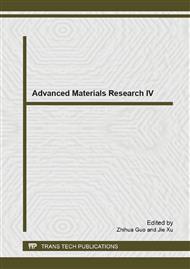[1]
Li-Yu Lin , Joong-Hee Lee , Chang-Eui Hong , Gye-Hyoung Yoo , Suresh G. Advani, Preparation and characterization of layered silicate/glass fiber/epoxy hybrid nanocomposites via vacuum-assisted resin transfer molding (VARTM), Composites Science and Technology 66 (2006).
DOI: 10.1016/j.compscitech.2005.12.025
Google Scholar
[2]
M. Al-Qadhi, N. Merah & Z. M. Gasem, Mechanical properties and water uptake of epoxy–clay nanocomposites containing different clay loadings, Journal of Materials Science 48 (2013): 3798–3804.
DOI: 10.1007/s10853-013-7180-5
Google Scholar
[3]
Yeh, J.M., and Chang, K.C., Polymer/layered silicate nanocomposites anticorrosive coatings, Journal of Industrial and Engineering Chemistry 14 (2008): 275-291.
DOI: 10.1016/j.jiec.2008.01.011
Google Scholar
[4]
Liu, T., Tjiu, W.C., Tong, Y., He, C., Goh, S.S., and Chung, T.S., Morphology and fracture behavior of intercalated epoxy/clay nanocomposites. Journal of Applied Polymer Science. 94 (2004): 1236-1244.
DOI: 10.1002/app.21033
Google Scholar
[5]
X. Kornmann , M. Rees , Y. Thomann , A. Necola , M. Barbezat , R. Thomann., Epoxy-layered silicate nanocomposites as matrix in glass fibre-reinforced composites, Composites Science and Technology 65 (2005): 2259–2268.
DOI: 10.1016/j.compscitech.2005.02.006
Google Scholar
[6]
B. Sharma, S. Mahajan, R. Chhibber, R. Mehta., Glass Fiber Reinforced Polymer-Clay Nanocomposites: Processing, Structure and Hygrothermal Effects on Mechanical Properties, Procedia Chemistry 4 ( 2012 ): 39 – 46.
DOI: 10.1016/j.proche.2012.06.006
Google Scholar
[7]
Emrah Bozkurt, Elc,in Kaya, Metin Tanog lu., Mechanical and thermal behavior of non-crimp glass fiber reinforced layered clay/epoxy nanocomposites, Composites Science and Technology 67 (2007): 3394–3403.
DOI: 10.1016/j.compscitech.2007.03.021
Google Scholar
[8]
Mohd. Zulfli, N. H., Abu Bakar A. and Chow W. S., Mechanical and thermal behaviours of glass fiber reinforced epoxy hybrid composites containing organo-montmorillonite clay, Malaysian Polymer Journal 7 (2012): 8-15.
Google Scholar
[9]
Yuanxin Zhou, Farhana Pervin, Vijaya K. Rangari, Shaik Jeelani., Influence of montmorillonite clay on the thermal and mechanical properties of conventional carbon fiber reinforced composites, Journal of Materials Processing Technology 191 (2007).
DOI: 10.1016/j.jmatprotec.2007.03.059
Google Scholar
[10]
M. Al-Qadhi, N. Merah, K. Mezghani, Z. Khan, Z.M. Gasem and R. Sougrat, Effect of High Shear Mixing Parameters and Degassing Temperature on the Morphology of Epoxy-Clay Nanocomposites' Advanced Materials Research 652-654 (2013): 159-166.
DOI: 10.4028/www.scientific.net/amr.652-654.159
Google Scholar
[11]
M. Al-Qadhi, N. Merah and K. Mezghani, Optimizing the Curing Process of Epoxy-Clay Nanocomposites, Key Engineering Materials 471-472 (2011): 415-419.
DOI: 10.4028/www.scientific.net/kem.471-472.415
Google Scholar
[12]
Manfredi, L.B., Santis, H.D., and Vázquez, A., Influence of the addition of montmorillonite to the matrix of unidirectional glass fibre/epoxy composites on their mechanical and water absorption properties, Composites Part A, 39 (2008): 1726-1731.
DOI: 10.1016/j.compositesa.2008.07.016
Google Scholar
[13]
Karippal, J.J., Narasimha Murthy, H.N., Rai, K.S., Sreejith, M., and Krishna, M., Study of mechanical properties of epoxy/glass/nanoclay hybrid composites, Journal of Composites Materials, 45 (2011): 1893-1899.
DOI: 10.1177/0021998310389087
Google Scholar
[14]
Yasmin, A., Lou, J.J., Abot, J.L., and Daniel I.M., Mechanical and thermal behavior of clay/epoxy nanocomposites, Composites Science and Technology, 66 (2006): 2415-2422.
DOI: 10.1016/j.compscitech.2006.03.011
Google Scholar
[15]
Haque, A., Shamsuzzoha, M., Hussain, F., and Dean, D., S2-Glass/Epoxy polymer nanocomposites: Manufacturing, structures, thermal and mechanical properties, Journal of Composite Materials, 37 (2003): 1821-1837.
DOI: 10.1177/002199803035186
Google Scholar
[16]
Swaminathan, G., and Shivakumar, K., Thermomechanical and fracture properties of exfoliated nanoclay nanocomposites, Journal of Reinforced Plastics and Composites, 30 (2011): 256-268.
DOI: 10.1177/0731684410393052
Google Scholar


